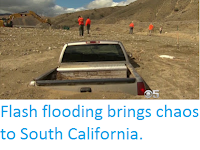A sinkhole that opened up in the Studio City distrct of Los Angelese, California, swallowed two cars on Friday 17 February 2017. The hole, which is described as being about six meters across, engulphed a car and its female driver as it opened. The driver of this vehicle was able to escape from the hole with the help of firefighters, but shortely after the hole expanded, swallowing a second vehicle.
Arial view of the 17 February 2017 Studio City sinkhole. ABC7News.
Sinkholes
are generally caused by water eroding soft limestone or unconsolidated
deposits from beneath, causing a hole that works its way upwards and
eventually opening spectacularly at the surface. Where there are
unconsolidated deposits at the surface they can infill from the sides,
apparently swallowing objects at the surface, including people, without
trace.
The approximate location of the 2017 February 2017 Studio City sinkhole. Google Maps.
On this occassion the sinkhole has been linked to the exceptional rainfall falling across California this week, which is thought to have burst a sewer beneath the road, then washed away the sediment around it until the road collapsed.
California has been battered by a succession of Pacific storms this year, bringing widespread flooding and triggering a number of landslip and
subsidence events. This is due to exceptionally high temperatures over
the Pacific Ocean off the coast of the state this year caused by a La Niña weather system over the southern Pacific.
This meant that the dam was already filled to capacity and regularly
using the spillways to remove water when the damage was discovered, with
another major series of storms due to start ariving later this week.
The La Niña weather system is the opposite of the El Niño weather
system, in which unusually cold surface temperatures spread across the
equatorial Pacific from the upwelling zone on the South American coast.
This traps warm water from the western Pacific, preventing it from
spreading east and warming the central Pacific. This leads to lower
evaporation over the (cooler) east Pacific, leading to low rainfall on
the west coast of South America, and higher evaporation over the
(warmer) west Pacific, leading to higher rainfall over East and
Southeast Asia and northern Australia.
The effects of a La Niña weather system in December-February. NOAA.
This also leads to a breakdown in surface circulation in the North
Pacific, which generally rotates clockwise, so that the same body of
water stays off the coast of California, where it is constantly warmed
by the Sun, leading to high levels of evaporation and onshore winds that
bring high rainfall and flood events to the state.
The effect of the La Niña weather system on the weather of North America. NOAA.
See also...
Follow Sciency Thoughts on
Facebook.










